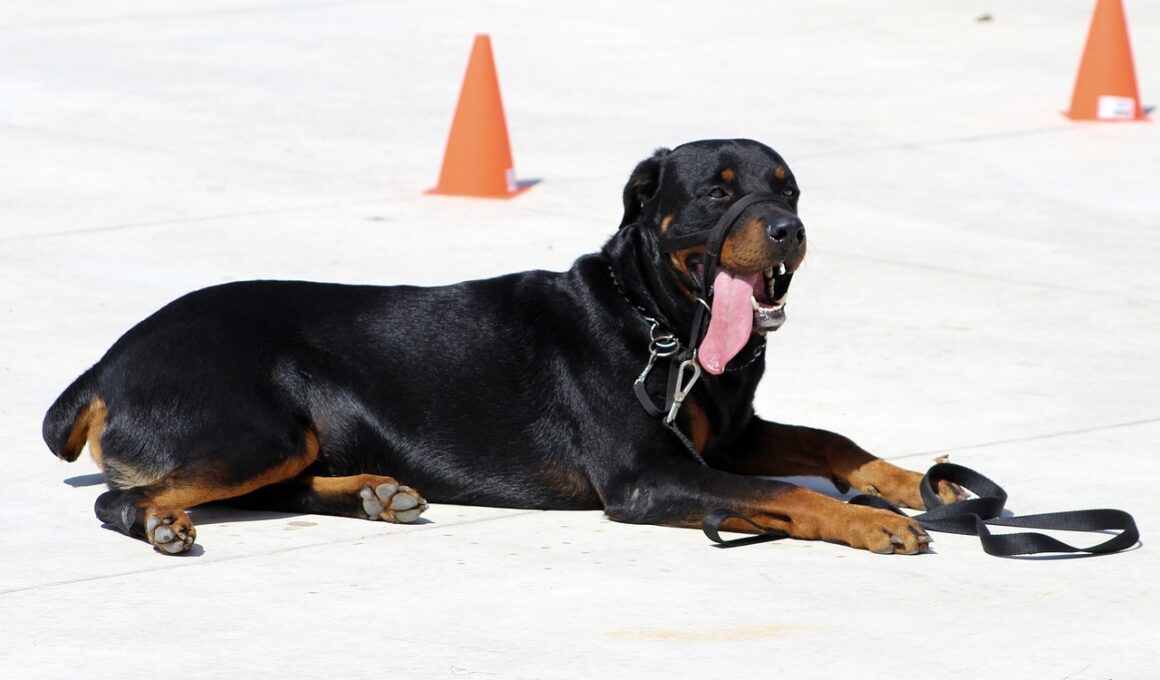The Essential Guide to Basic Dog Commands
Training your dog in basic commands is essential for building a strong bond and ensuring good behavior. These commands can also keep your dog safe in various situations. Essential commands include ‘sit,’ ‘stay,’ ‘come,’ ‘down,’ and ‘leave it.’ Each command serves a specific purpose, whether it’s to establish control or to prevent dangerous situations. Consistent training fosters better communication between you and your pet. Start with short training sessions during which you reward your dog for correct responses. This method utilizes positive reinforcement, encouraging your dog to repeat desired behaviors. Make sure to use clear gestures and verbal cues for each command. Always practice in a distraction-free area to ensure that your dog is focused and engaged. Gradually introduce distractions. It’s also important to understand your dog’s learning pace. Some dogs may learn quickly, while others might require more time. Keeping training sessions fun and engaging helps improve your dog’s enthusiasm towards learning commands. Early training will yield long-lasting results that benefit both you and your furry friend. Always end on a positive note, so your dog associates training with a fun experience!
The command ‘sit’ is a foundational command that serves as the basis for other teachings. To teach this command, begin by holding a treat close to your dog’s nose. Once they take note of the treat, slowly move your hand upward, causing your dog to naturally lower their rear. As their bottom touches the ground, immediately say ‘sit’ and reward them with a treat. It’s important to practice this in a quiet environment before introducing distractions. Continue to practice regularly, gradually increasing the time between the command and the reward. Teaching ‘sit’ can help with impulse control and establish immediate obedience. You can use this command to calm your dog in potentially exciting situations, ensuring better behavior. Additionally, ‘sit’ is often a precursor to additional commands such as ‘stay’ or ‘down.’ Consistent reinforcement is critical for ensuring your dog will respond well when called upon. Remember to stay patient and give praise. Having a strong grasp of the ‘sit’ command will enhance overall training effectiveness and improve your dog’s confidence, fostering a lifelong understanding of other commands too.
The Importance of ‘Stay’
‘Stay’ is a command that teaches your dog to remain in a set position until you give them further instructions. This command is extremely useful for safety in various scenarios, such as when guests arrive or during walks. To train the ‘stay’ command, first, have your dog in the ‘sit’ position. While facing your dog, say ‘stay’ in a firm voice and take a step back. If they remain in position, return quickly and reward them with praise or a treat. Start with short distances and small time frames. Gradually increase both distance and duration as your dog becomes more comfortable with the command. Consistency is key; practice daily in different environments to ensure they understand the command in various contexts. Over time, your dog will learn to remain in place until they hear the release command, such as ‘okay’ or ‘free.’ Remember to mix training with play to keep it light-hearted and fun. A well-trained dog that understands ‘stay’ is also much easier to manage in busy situations, providing peace of mind for their owner.
Another important command is ‘come,’ which can be a lifesaver in emergency situations. The goal is to have your dog return to you immediately when called. To begin training, choose a command word, like ‘come’ or ‘here,’ and use it consistently. Start in an enclosed space, allowing your dog to roam freely. Call your dog by name, followed by the chosen command. When they come to you, offer enthusiastic praise and a treat. Over time, practice using the command outdoors in various settings. Gradually increase the distance and introduce distractions, rewarding compliance every time. It’s crucial to maintain enthusiasm when your dog arrives, reinforcing the positive association with your voice. If they don’t come right away, use a high-energy tone to draw their attention. Avoid using the command in a negative context, like during bath time, to ensure your dog has a positive association with ‘come.’ This command not only strengthens your bond but also fosters reliable recall, which is essential for their safety. Properly training the ‘come’ command allows for enjoyable walks and outdoor experiences.
Mastering ‘Down’ Command
The ‘down’ command encourages your dog to lie down, which can be helpful in calming excited behavior. It also serves as a precursor to commands like ‘stay.’ To teach this command effectively, begin with your dog in a standing position. Use a treat to lure your dog’s head towards the ground. As they lower, say ‘down’ and reward them as soon as their belly is on the floor. Be patient; this may take time for some dogs to understand. Gradually phase out the treat after your dog has learned to associate the verbal cue with the action. Practice this command in different environments to help solidify it. Remember to praise your dog for compliance, as positive reinforcement is crucial during training. If your dog refuses to lie down, avoid forceful methods as this can create anxiety or fear. Instead, use encouragement and patience. With consistency, the ‘down’ command can help your dog learn to settle in various situations, creating a calmer atmosphere and establishing better behavior when guests are present.
The command ‘leave it’ is essential for keeping your dog safe from hazardous items or situations. It teaches them to ignore distractions and refrain from picking up objects. To train this command, start with a treat in your hand and show it to your dog without letting them take it. When they attempt to grab it, say ‘leave it’ in a firm voice. Close your hand if necessary to prevent access, waiting until they stop trying before rewarding them with a different treat from your other hand. Repeat until they understand the command. Once your dog responds consistently, practice with items around the house, gradually introducing more exciting distractions outside. Always reward them when they obey the ‘leave it’ command. This training not only ensures safety but also instills self-control. Practicing this command can prevent your dog from consuming harmful foods or getting into unwanted situations. As they grow to understand and obey the ‘leave it’ command, their obedience in everyday situations will help foster a safe, enjoyable experience for both the dog and owner.
Consistency and Patience: Keys to Success
In conclusion, successful dog training heavily relies on consistency and patience. Utilizing basic commands not only establishes structure but also enhances the bond with your dog. Regular practice fosters an environment for effective learning. Each dog is unique, meaning some will grasp commands quickly while others need more time and repetitions. It is essential to remain patient and supportive throughout the process. When training, keep the sessions short and positive to maintain your dog’s enthusiasm. Incorporating playtime creates a fun atmosphere, reinforcing good behavior while creating joyful moments. Utilizing rewards such as praise and treats, ensures that your dog associates training with positive experiences. This relationship builds trust, making your dog more likely to respond to commands in challenging situations. As your dog becomes proficient with basic commands, you can progress to more advanced training. However, never forget the foundation that basic commands provide. The joy and satisfaction of having a well-behaved dog are immense, enriching both your lives. Embrace this training journey, knowing that every moment spent teaching is an investment in your dog’s happiness and safety.
By implementing these basic dog commands into training routines, you provide your canine companion with the necessary tools to thrive in any environment. With practice, your dog will learn to respond positively to commands, leading to improved behavior and a strong owner-dog relationship. Training should be an ongoing process; make adjustments as your dog grows and learns. Enjoy this time together, and celebrate every small victory along the way. Remember, a well-trained dog reaps benefits for both the owner and the pet, leading to a satisfying companionship. The journey of dog training can be both rewarding and fun, bringing joy to your lives as you navigate through each command together. Enjoy building a deeper, trusting connection with your furry friend as they learn the meaning behind each command. Take it step by step, and with commitment, you will undoubtedly see successful results. Your efforts will manifest in a well-mannered dog that understands and obeys your cues. So, whether you’re teaching ‘come,’ ‘stay,’ ‘sit,’ or others, embrace the adventure and relish every moment spent training your loyal companion!


